Abstract
Recently, the requirements regarding the environment of nursing homes are high, because the elderly are a vulnerable group with limited adaptive capacity to respond to transient environmental change. This paper presents a field investigation on the influence of transient thermal comfort changes between the indoor and outdoor spaces (i.e., air temperature (Ta), solar radiation (SR), relative humidity (RH), wind speed (WS), and the thermal comfort indices of Universal Thermal Index (UTCI)) on the willingness of the elderly to use outdoor spaces of the Wanxia nursing home of Chengdu City. Results indicated that, in summer, the mean UTCI values of indoor and corridor spaces corresponded to the level of moderate heat stress, while those of road and garden corresponded to the strong heat stress level. Road and garden spaces even showed moderate heat stress in spring. Approximately 28.93% (139) of the elderly living here used outdoor spaces every day. The morning period (from 9:00 a.m. to 10:00 a.m.) was the elderly’s favorited period for using outdoor spaces in seasons. The microclimatic transient differences between indoor and outdoor spaces ranged from 0.47 °C to 2.93 °C (|ΔTa|), from 86.09 W/m2 to 206.76 W/m2 (|ΔSR|), from 5.29% to 14.76% (ΔRH), from 0.01 m/s to 0.07 m/s (|ΔWS|), and from 0.25 °C to 2.25 °C (ΔUTCI). These big microclimate differences could cause enormous health risks for the elderly in the process of indoor and outdoor space conversion. The minimal transient change occurred between corridors and indoors. Pearson correlation analysis indicated ΔTa and ΔRH between indoor and outdoor spaces were the primary meteorological factors that influenced the elderly’s willing to use outdoor spaces. The elderly preferred to live in a constant Ta and RH environment. Only when the ΔTa and ΔRH are small enough to resemble a steady-state (ΔUTCI ≤ 0.5 °C), ΔWS and ΔSI could affect the elderly’s choice of using outdoor space. Optimal design strategies were put forward for reducing the transient differences between indoor and outdoor microclimates to inspire the elderly to use outdoor spaces safely, including improving outdoor canopy coverage and indoor mechanical ventilation.
1. Introduction
With increasing life expectancy and plummeting birthrates, the world population is rapidly aging [,,]. As China’s older population is the most populous in the world, there is no doubt that China will soon encounter particularly acute challenges from the aging population. The total number of elderly aged 65+ in China was estimated to increase to 23.9–26.9% of the total population by 2050 []. Because of the shrinking family size (commonly with a 4-2-1 structure, with four grandparents, two parents, and one child), the frequent population flow, the improving social pension system, and the modernization of living patterns, an increasing number of Chinese elderly will have to trade traditional family care for institutional care.
In China, an important period of strategic opportunity for the development of nursing homes has arrived. The number of Chinese elderly who joined nursing homes grew at an unprecedented rate from 1.20 million in 2006 to 3.79 million in 2017 []. From 2009 to 2017, the number of beds in nursing homes increased from 2.58 million to 7.47 million []. However, despite the large gap in beds of nursing homes for the Chinese elderly, the vacancy rate of nursing homes was very high (e.g., 47% for Beijing and 35% for Shanghai in 2017) []. The reasons may be that the built environment, fees, and nursing services of nursing homes are not meeting the demands of the elderly []. In urban areas, the elderly are willing to wait for many years for a bed in a superior nursing home. Thus, to enhance the attractiveness of institutional care for the elderly, research has recently focused on the built environment of the nursing home.
Regarding the indoor environment of nursing homes, Mendes et al. [] reported that most (64%) of the occupants of nursing homes of Porto City, Portugal, were dissatisfied with the indoor temperature. The Thai elderly living in nursing homes need indoor temperatures of 27.78 °C []. In the seven nursing homes of Utrecht City, the Netherlands, at least 65% of all common rooms had poor vertical illuminance, which remained significantly below the demand of the elderly of 750 Lux []. Residents in 15 aged care facilities that were both warm and moist were found to have low health risk []. Furthermore, keeping the door open or running air-conditioners were identified as important measures for air quality improvement in nursing home rooms []. The influence of outdoor climate on indoor microclimate, especially during heat stress events, has also been found []. Indoor temperature is mainly influenced by outdoor temperature []. Due to the physical characteristics of the building, indoor climate differs within the spatial and temporal differences in outdoor temperature in Berlin []. In addition, thermal comfort and adaptation are considered important issues in the environmental design of nursing homes, because the thermal sensation of the elderly is different from that of the young [].
A few studies have pointed out the outdoor spaces, especially the internal gardens, of nursing homes fulfill the functions of relief from physical symptoms, improvement of bodily function [], stress and anxiety reduction [], communication [], and building self-confidence []. However, the above benefits the elderly obtained were based on the premise that the outdoor spaces were sufficiently comfortable to attract the elderly to use and enjoy these []. Previous research indicated that thermal comfort was one of the main factors that determine the quality and use of outdoor spaces [,,]. In the hot-dry Mediterranean regions, the internal gardens provide a passive cooling effect to attract people to enter them []. The attenuation peaks of 6.4 °C on a cold day and 5.0 °C on a hot day were found in the internal courtyard in tropical climates []. The thermal comforts of the internal gardens in eight nursing homes in Chengdu City partially deviated from the elderly’s demands, especially in winter by thermal/humidity/radiation sensation votes []. However, previous efforts in thermal comfort research of nursing homes have been mostly focused on steady-state conditions [,].
Actually, the thermal environment is often transient and dynamic, such as moving indoors from outdoors, or moving from indoors to outdoors []. However, neither ASHRAE standard 55-2010 nor ISO 7730 provide a clear description of the thermal comfort in the transient environment, and the macroclimatic step-change transients of the elderly remains relatively poorly understood []. Older adults represent a vulnerable group as they have limited adaptive capacity to respond to the transient environment, and may consequently suffer thermal stress, cold stress, and solar stress [,]. Even the daily temperature fluctuation in one room may induce increased variation in the blood pressure of the elderly []. Moreover, their ability to respond to environmental changes is far weaker in winter and summer []. In China, the elderly who choose nursing homes are generally older and weaker than the average elderly, the proportion of disabled and semi-disabled elderly in nursing homes has continued to grow. The outdoor spaces of nursing homes could be the only space where the elderly may encounter nature. In search of bases for the design of more pleasant and healthy spaces in nursing homes, this study aims to (a) investigate the transient thermal comfort between indoor and outdoor spaces in nursing homes during four seasons; (b) clarify the transient microclimatic changes that may yield sufficient comfort and safety for the elderly to use outdoor spaces in all seasons, by assessing the usage patterns of these spaces; (c) adjust environmental design strategies for constructing a comfortable and balanced microclimate between indoor and outdoor spaces. These results inform the thermal comfort and energy-saving design of nursing homes.
2. Material and Methods
2.1. Sample Selection
The nursing home assessed by this study is the Wanxia Elderly Service Center (abbreviated as Wanxia nursing home) in Jinniu District of Chengdu City (30°05′ N–31°26′ N, 102°54′ E–104°53′ E), which is situated in the political and commercial center of western China [] (Figure 1). As of the end of 2019, Chengdu City had a registered population of 15.07 million, 3.16 million of whom were aged 60 years of older, and the aging rate reached 21.07%, ranking third in China. Chengdu City has 546 nursing homes, with a total of 125,000 beds (including preparations), representing 39 beds per 1000 elderly. The coverage of elderly care facilities in urban communities has reached 97% (Chengdu Statistical Yearbook).
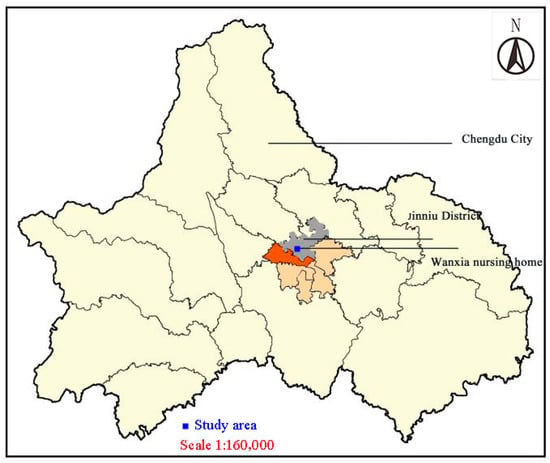
Figure 1.
The location of the Wanxia nursing home, Chengdu City, China.
Chengdu City is situated in the hot summer and cold winter zone of China. The mean air temperature (Ta) of the hottest month of July is about 2 °C higher than that of other places with the same latitude across the world. The mean Ta of the coldest month of January is about 8–10 °C lower than that of other places with the same latitude across the world []. In 2020, the average daily Ta in summer (from June to August) was 31 °C, and the highest Ta was 39 °C. The average Ta in winter was 11 °C, and the lowest Ta was 3 °C []. Chengdu City belongs to a typical calm wind area. The annual mean wind speed (WS) is 0.7 m/s, and from 1980 to 2010, the frequency of calm weather in Chengdu City was approximately twice (24.06 days) that of other regions in China []. In addition, Chengdu City has a high annual mean relative humidity (RH) (77.6%) and the lowest annual mean sunshine duration (of 925.7 h) in China (China meteorological administration, 2004–2015).
Wanxia nursing home is the largest privately run aged care facility in Chengdu city, with a total of 500 beds. The area of Wanxia nursing home is about 46,666.66 m2, and the green space rate here has reached 61.78%. Northeast facing buildings in this facility are in a determinant layout. Four two-story accommodation buildings are located in the west part of the nursing home, and the other buildings are on one floor. The east of the accommodation buildings is the main road with a width of 4 m. A total of 482 old people live in this nursing home with an average age of 82 years. Of these 482 elderly people, 161 (33.40%) are men and 321 (66.60%) are women. More than 90% are over 80 years old and 2.8% are over 90 years old. More than half of the elderly are disabled, who have to rely on a caregiver to move, and moreover it did not include the elderly with dementia. Due to the civilian price, there is no standard daily care procedure for taking these disabled elderly out of their bedrooms to enjoy the outdoor sunshine.
2.2. Instruments and Measurement Methods
The nursing home was divided into indoor and outdoor spaces (Figure 2a). Outdoor spaces include covered corridor spaces (abbreviated as corridor), road spaces, and garden spaces. The indoor spaces are the bedrooms. Corridors are adjacent to the bedroom. Garden spaces provide sport and seat facilities. To evaluate the daily microclimatic variation of this nursing home throughout the seasons, five measurement sites (namely one covered corridor (Figure 2b), one main road (Figure 2c), one garden (Figure 2d), and 2 bedrooms (Figure 2e,f)), were chosen and microclimatic factors were simultaneously monitored from March 2020 to February 2021. In order to avoid walking difficulties affecting the use of outdoor spaces by older adults, two bedrooms on the first floor, facing northeast, were selected for the purpose of this study, with the total inside area of 31.9 m2 and floor to ceiling height of 3.3 m (Figure 2e). Four elderly people lived in each bedroom, where there was a state of complete natural ventilation without any heating or fresh air system. The covered corridors, gardens and roads are all located closest to the 2 bedrooms.
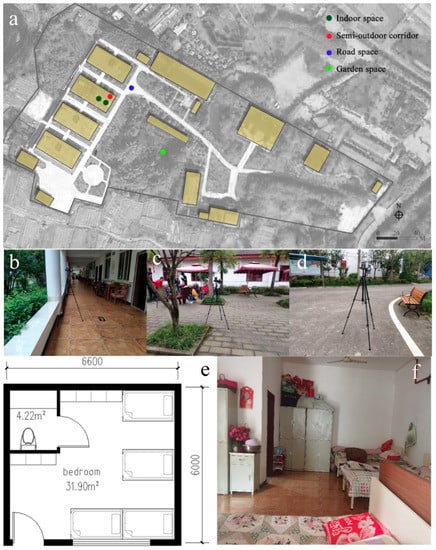
Figure 2.
The indoor and outdoor spaces of the Wanxia nursing home. (a) Distribution map of measuring points, (b) corridor space, (c) garden space, (d) road space, (e) and (f) indoor space.
Indoor and outdoor Ta, RH, and WS were measured using the Kestrel 5500 portable weather station (Nielsen-Kellerman, Boothwyn, PA, USA). The portable TES 1333R (Tes, Taipei, Taiwan, China) and AZ 8758 (AZ Instrument Corp, Taichung, Taiwan, China) instruments were used to estimate solar radiation (SR) and globe temperature (Tg). These instruments were installed horizontally in the center of outdoor spaces, 1.5 m above the ground level. Indoor fixed measurement units were placed at that side of the bedroom with sufficient distance to door and window. In order to prevent the elderly from tripping, the tripod of the instrument was removed, and these instruments were placed on a 1.5 m high cabinet. Considering that the elderly used these spaces in the daytime, at least two days in each month were randomly selected and the measurement work was carried out during spring (26 and 27 March; 27 and 28 April; 28 and 29 May), summer (15, 16 and 20 June; 19, 23, 24, and 27 July; 4, 6, 8, and 9 August), autumn (16 and 26 September; 10, 11, 14 October; 15 and 16 November), and winter (26 and 27 December; 2, 9 and 19 January; 19 and 26 February) in 2020, at 5 min intervals from 9:00 a.m. to 18:00 p.m. as these are the central hours of the daytime, as well as being the moments of the most active time for elderly. In addition, all measured spaces were not given any additional light source during 9:00 a.m. to 18:00 p.m. No data were recorded on rainy days. All indoor and outdoor measurements were carried out simultaneously. Then, to clear the effects from atmospheric and thermal comfort differences between the bedroom, corridor, road, and garden on the elderly’s preference of space use, we analyzed the pairwise differences in Ta, RH, SR, WS, and UTCI values of these spaces, such as the Ta difference (abbreviation ΔTa), ΔT1 = Ta(indoor space) – Ta(corridor space), ΔT2 = Ta(indoor space) – Ta(road space), and ΔT3 = Ta(indoor space) – Ta(garden space).
2.3. Elders Observations
Direct observation was applied to identify the patterns of use and stay of the elderly in the different spaces in this nursing home. How many elders entered and stayed in these spaces more than 5 min during the measurement was recorded and then which space elders would like to choose every one hour was analyzed. Simultaneously, a series of personal factors, such as clothing and activity level, were also assessed. The total clothing insulation value (Clo) for an individual was calculated using Equation (1) []:
where
- IClo is the total clothing insulation value;
- IClu,i is the insulation value for each piece of clothing in the unit of Clo.
The insulation value for each piece of clothing referred to ASHRAE Standard 55-2013 and GB/T 50785-2012.
2.4. Data Analysis Methods
In this study, microclimatic parameters were calculated for each measurement day, and the mean values were calculated for the whole season. Then, the mean values of microclimatic parameters were used to calculate universal thermal climate index (UTCI). UTCI is considered as one of the most complete, objective, and efficient performance indices for evaluating the outdoor thermal comfort in urban and landscape planning and design [,], such as the urban residential blocks in Nanjing, China [] and the university campus in Shanghai, China []. Moreover, UTCI based on a multi-node dynamical model of human heat transfer and temperature regulation with a 10-level scale [], represents the temporal variability of thermal conditions better than the other indices []. In recent years, UTCI has also been suggested to calculate indoor thermal comfort. Walikewitz et al. [] found all rooms in eight buildings in Berlin, Germany, experienced heat stress according to UTCI levels, especially during summer heat waves. Grifoni et al. [], using UTCI, revealed how cool façades help to improve indoor conditions in Italy.
The UTCI was used to describe the thermal comfort of the different spaces in this nursing home, which is a bio-meteorological index for the assessment of thermally induced stress and reflects even slight differences in the intensity of meteorological stimuli []. Ta, Tmrt, RH, and WS(x = 10) were used to calculate the UTCI [] (see Equation (2)). Globe thermometers combined with air temperature and wind speed sensors were used for obtaining Tmrt (see Equation (3)). Equation (4) below was used to convert our 1.5 m wind speed to WS(10 m), which was required to calculate the UTCI [].
where
UTCI = f (Ta; Tmrt; WS(x = 10); RH)
- Tmrt (°C) is the mean radiant temperature, which was calculated with Equation (3);
- WS(x = 10) is the wind speed at a height of 10 m above the ground, and was calculated using Equation (4);
- ε is the emissivity of the globe which is normally assumed as 0.95 [];
- D is the diameter of the globe (m), and the diameter of the globe (0.075 m) used in this study.
The calculation process was performed by the UTCI website (www.utci.org (accessed on 12 August 2021)). Due to people’s thermal comfort differing between different climate zones in China, the different assessed spaces can be classified according to thermal comfort levels modified for Chinese [], as shown in Table 1. Compared with the UTCI thermal stress scale proposed by Bröde et al. [], the lowest threshold of the cold stress rises from −40 °C to −21 °C, and the range of no thermal stress level is reduced from 9–26 °C to 12–25 °C.

Table 1.
UTCI assessment scale (Adapted from Ref. []).
Pearson’s correlation analysis in SPSS 11.0 (SPSS Inc, Chicago, IL, USA) was used to assess the effect of the indoor and outdoor microclimatic differences on the number of the elderly who used outdoor spaces using. The results are expressed as 95% confidence intervals. Origin 8.0 was used to draw charts and for function fitting.
Based on the key microclimatic parameters affecting the choice of using outdoor spaces for the elderly, the day and the spaces with the largest differences between parameters concerning indoor and outdoor spaces were selected to carry out the simulation. This outdoor data were fed as boundary conditions to ENVI-met (version 4.1), a state-of-the-art CFD based urban microclimate modelling software. The 3D model of the outdoor space was set up in ENVI-met with a grid resolution of 7 m × 7 m (Figure 3). Even though the indoor spaces only focused on bedroom space, it was also created in the simulation as a multi-zone 3D model in Fluent Airpak software 3.0 (Fluent Inc., NYC, USA)based on the original building drawings provided by the local municipality (Table 2). Indoor Ta, RH, and WS were simulated at 0.6 m (lying position) and 1.2 m (sitting position) of the mannequin, respectively. Simulations were executed at 1 h interval from 9:00 a.m. to 18:00 p.m. Subsequently, the adjustment strategies for indoor and outdoor microclimatic differences were proposed based on the simulation at the moment of the day with the largest key parameter difference.
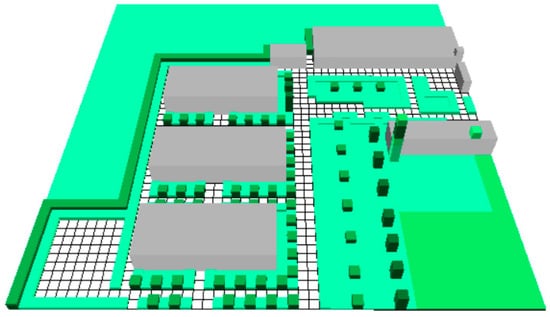
Figure 3.
ENVI-met model of the study area.

Table 2.
Bedroom parameters and boundary conditions.
3. Results
3.1. Seasonal Usage of Different Outdoor Spaces by the Elderly
Approximately 28.93% (139) of the elderly living in this nursing home used outdoor spaces every day throughout the whole year, including those who walked on their own or asked nursing staff to push themselves into the outdoor spaces using wheelchairs. The highest usage ratio of the elderly was observed in autumn (29.88%, 144), followed by 29.25% (141) in spring, 29.05% (140) in winter, and 27.39% (132) in summer (Figure 4). Among them, the number (105, 21.84%) of the elderly in corridors was much higher than those in road (25, 5.83%) and garden spaces (9, 1.78%). In addition, 9:00 a.m. to 10:00 a.m. was the elderly’s favorited period for using outdoor spaces over four seasons. More than one half (51.79–67.62%) of the elderly preferred to sit and chat, followed by slow walking (28.78–43.16%). Only a few (4.31–5.04%) elderly performed exercises using sport instruments. Figure 5 summarizes the seasonal distribution of the thermal resistance for clothing worn by the elderly in nursing home. Furthermore, 50% of the values are concentrated in the range of 0.81—0.96 Clo in spring, 0.39–0.61 Clo in summer, 1.10–1.14 Clo in autumn, and 1.68–1.93 Clo in winter. The mean insulation values of the clothing worn by the elderly were significantly different in seasons (p < 0.05).
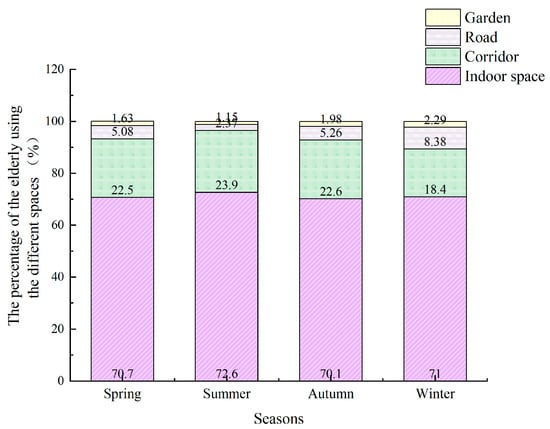
Figure 4.
The seasonal usage patterns of indoor and outdoor spaces by the elderly.
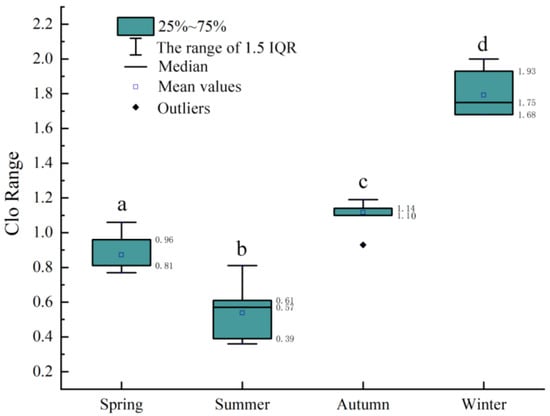
Figure 5.
The seasonal Clo range of the elderly in nursing home. Note: Values followed by different letters (a, b, c, d) indicate there is statistically significant difference among the treatment groups at p ≤ 0.05 (5%) according to the multivariate general linear model followed by a Duncan’s post hoc test in SPSS. The common letters indicate there is no significant difference among groups.
3.2. The Seasonal Differences of the Microclimatic Condition between Indoor and Other Spaces
3.2.1. Seasonal Ta and Ta Difference (ΔTa)
Table 3 shows that mean Ta fluctuated within 23.3–26.52 °C in spring, 28.58–32.29 °C in summer, 19.75–20.24 °C in autumn, and 11.81–12.59 °C in winter. The lowest and highest mean Ta was observed in corridors at winter and in road spaces during summer, respectively. In spring and summer, a decreasing trend of Ta (road) > Ta (garden) > Ta (corridor) > Ta (indoor space) was shown. Indoor Ta was directly affected by the changes in outdoor Ta. The |ΔTa| between indoor and outdoor spaces was highest in summer (2.93 °C), followed by spring (2.47 °C), and the smallest mean |ΔTa| value occurred in autumn (0.25 °C). Figure 6a shows that all values of mean ΔT2 and ΔT3 are positive in all four seasons, which confirms the heating effect of outdoor spaces. The largest values of |ΔT1| (1.38 °C), |ΔT2| (3.71 °C), and |ΔT3| (3.69 °C) were consistently observed in summer, the lowest values of |ΔT1| (0.02 °C) were observed in winter, and the lowest |ΔT2| (0.42 °C) and |ΔT3| (0.39 °C) occurred in autumn (Figure 6a). In spring, summer, and autumn, a consistent trend of |ΔT2| > |ΔT3| > |ΔT1| was found. However, a trend of |ΔT3|> |ΔT2| >| ΔT1| was observed in winter. |ΔT1| values in all seasons were significantly smaller than |ΔT2|and |ΔT3| values. Figure 7 shows that all minimum values of |ΔT1|, |ΔT2|, and |ΔT3| during the daily survey time were observed from 9:00 a.m. to 10:00 a.m. in both spring and summer. However, in autumn and winter, these minimum values occurred from 16:00 p.m. to 18:00 p.m.

Table 3.
Seasonal mean values of the microclimate parameters in four spaces.
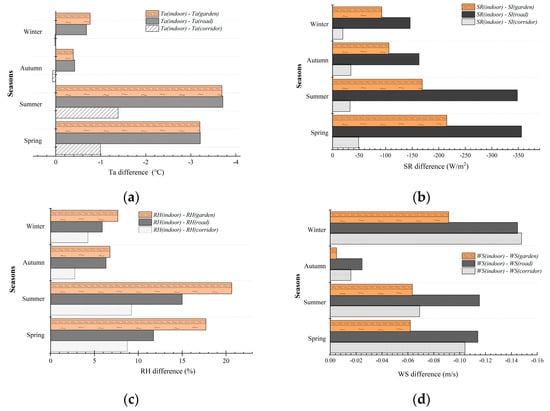
Figure 6.
The seasonal microclimatic differences of indoor and outdoor spaces. (a) Ta; (b) SR; (c) RH; (d) WS.
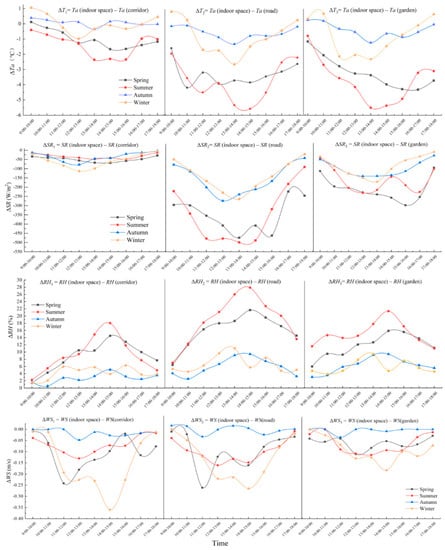
Figure 7.
The daily fluctuation of the atmospheric differences between indoor and outdoor spaces.
3.2.2. Seasonal SR and SR Difference (ΔSR)
The seasonal mean SR across all four spaces fluctuated between 0.95 W/m2 (winter) and 16.62 W/m2 (summer) in indoor spaces, between 20.3 W/m2 and 51.86 W/m2 in corridors, between 147.10 W/m2 (winter) and 367.86 W/m2 (summer) in roads, and between 93.70 W/m2 (winter) and 217.94 W/m2 (spring) in gardens (Table 3). A very clear trend of SRroad > SRgarden > SRcorridor > SRindoor was found in all seasons. Figure 6b shows that all values of mean ΔSR are positive in four seasons. SR interception was not evenly distributed in outdoor spaces, and further showed the trend of |ΔSR2| (253.30 W/m2) > |ΔSR3| (145.75 W/m2) > |ΔSR1| (33.99 W/m2). The largest mean ΔSR (|ΔSR2| = 355.94 W/m2) occurred in spring, but the smallest mean ΔSR (|ΔSR1| = 19.4 W/m2) occurred in winter. Almost all minimum values of |ΔSR1|, |ΔSR2|, and |ΔSR3| were observed from 17:00 p.m. to 18:00 p.m. in seasons, except for the minimum |ΔSR3| in summer, which occurred from 09:00 a.m. to 10:00 a.m. (Figure 7). All maximum values of |ΔSR| uniformly occurred from 12:00 p.m. to 14:00 p.m., except in spring and summer, the maximum values of |ΔSR1| were observed from 14:00 p.m. to 16:00 p.m.
3.2.3. Seasonal RH and RH Difference (ΔRH)
The mean RH values ranged from 55.14% (gardens) to 68.35% (indoor spaces) (Table 3). Moreover, the values followed the same rank (i.e., RHindoor > RHcorridor > RHroad > RHgarden) in seasons. It is indicated that outdoor spaces generated less humidity than indoor spaces. In spring, summer, and autumn, RH values of both indoor and corridor spaces exceeded 60%, while all RH values of them remained below 60% in winter. The highest mean ΔRH (13.20%) was observed between indoor spaces and gardens (ΔRH3), and the lowest value (6.25%) was observed between indoor spaces and corridors (ΔRH1) (Figure 6c). Gardens showed optimal humidity decreasing effects. In addition, the seasonal mean ΔRH followed the ranking of ΔRHsummer (14.96%) > ΔRHspring (12.73%) > ΔRHwinter (5.94%) > ΔRHautumn (5.29%). During the daily survey time, ΔRH values followed a trend of increasing first and then decreasing from morning to afternoon (Figure 7). Almost all minimum values of ΔRH occurred from 09:00 a.m. to 11:00 a.m., except for ΔRH2 in summer (which occurred from 17:00 p.m. to 18:00 p.m.). All maximum values of ΔRH1, ΔRH2, and ΔRH3 were uniformly observed from 13:00 p.m. to 15:00 p.m.
3.2.4. Seasonal WS and WS Difference (ΔWS)
Because this nursing home has no mechanical ventilation facility, WS values always showed 0 m/s in the indoor spaces. Due to the generally calm conditions prevalent for Chengdu City, the seasonal mean WS of the outdoor spaces was very low (<0.2 m/s) and had a calm status in seasons (Table 3). However, WS was not uniformly distributed in these outdoor spaces. The highest mean values of |ΔWS| occurred in road spaces (0.1 m/s), followed by corridor spaces (0.08 m/s) and garden spaces (0.06 m/s) (Figure 6d). In winter, |ΔWS| was significantly higher than in other seasons. During the daily survey time, all minimum values of |ΔWS1|, |ΔWS2|, and |ΔWS3|occurred from 09:00 a.m. to 10:00 a.m. in autumn and winter (Figure 7). The maximum |ΔWS| values between indoor and outdoor spaces were uniformly observed from 11:00 a.m. to 15:00 p.m.
3.3. The Thermal Comfort Differences between Indoor and Outdoor Spaces
Figure 8a indicates that the stress categories of indoor and corridor spaces were at the same level with no thermal stress in spring, autumn, and winter. The mean UTCI values of indoor and corridor spaces in summer corresponded to the level of moderate heat stress, while the mean UTCI values of road and garden corresponded to the level of strong heat stress (≥33 °C). Note that road and garden spaces even showed moderate heat stress (≥25 °C, <33 °C) in spring, which meant that the health of the elderly could be at thermal risk in summer and spring. That could be due to road spaces being generally uncovered, providing spaces without shade and high Ta.
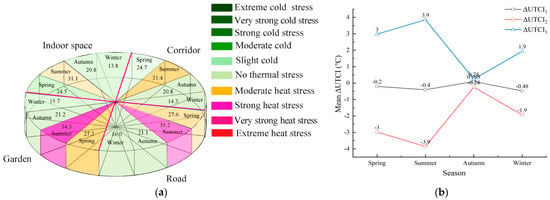
Figure 8.
(a) The seasonal mean UTCI values of the four spaces; (b) The seasonal ΔUTCI values of the four spaces.
In the daily survey time, a slight cold stress level (<12 °C) of all spaces has been observed between 09:00 a.m. and 10:00 a.m. at winter. The slight cold stress level lasted longer (09:00 a.m. to 11:00 a.m.) in corridors than other places. During this period, the elderly should avoid using outdoor spaces. In summer, all the UTCI values were not at the level of no thermal stress. Both roads and gardens reached the strong heat stress level after 11:00 a.m. During this period, the elderly’s outdoor activities are not recommended. These spaces correspond to configurations where the sun easily penetrates in spring and summer. Therefore, these spaces need partial shading.
The highest mean ΔUTCI values (−2.25 °C) were observed between indoor spaces and road (ΔUTCI2), and the lowest mean value (−0.25 °C) was observed between indoor spaces and corridors (ΔUTCI1) (Figure 8b). During the daily survey time, ΔUTCI values followed a trend of increasing first and then decreasing from morning to afternoon. The maximum ΔUTCI2 (−3.12 °C) and ΔUTCI3 (−2.92 °C) uniformly occurred from 12:00 p.m. to 13:00 p.m. In contrast, the maximum ΔUTCI1 occurred with a time lag of two hours. The minimum ΔUTCI2 (−0.7 °C) and ΔUTCI3 (−0.4 °C) were uniformly observed from 9:00 a.m. to 10:00 a.m., while the minimum ΔUTCI1 occurred from 17:00 p.m. to 18:00 p.m.
3.4. Correlation Analysis
Pearson correlation (Table 4) analysis showed that the user numbers of both roads and gardens were significantly positively and negatively correlated with ΔTa and ΔRH. This reflects that the larger the Ta difference and the smaller RH difference between indoor and outdoor spaces, the less willing the elderly are to use the outdoor space. The warmer the outdoor space is than indoors, the greater ΔRH between indoor and outdoor is; the fewer elders will use these spaces. This can explain that the corridor had an uncomfortable microclimate (e.g., the lowest mean Ta in winter, the least sunlight, and higher RH than other outdoor spaces), but it was still the favorite outdoor spaces for the elderly, because of the smallest microclimatic difference compared with indoor spaces. The elderly’s favorite period (from 9:00 a.m. to 10:00 a.m.) for using outdoor spaces also happened to be the period with the smallest difference between indoor and outdoor microclimates. If ΔTa and ΔRH values between indoors and outdoors were small enough, such as in corridors, where the Ta and RH were very close to those of indoors, the elderlies’ choice of using outdoor spaces was susceptible to ΔSI, ΔWS, and ΔUTCI. The greater ΔSI1, ΔWS1, and ΔUTCI1 values encourage more elderly to use corridors. ΔUTCI1 was only extremely significantly correlated with ΔWS1 (R = 0.523, p ≤ 0.01).

Table 4.
Correlation between the user numbers and the microclimate differences of outdoor spaces the in nursing home.
Based on the key microclimatic parameters (Ta and RH), which affected the choice of using outdoor spaces for the elderly, 27 July 2020, when thermal comfort was at the highest level of strong heat stress, was selected to carry out the simulation. The road spaces and bedroom with the highest ΔTa and ΔRH were simulated for Ta and RH (Figure 9a,b). R2 is the reconciliation coefficient, indicating the degree of correlation between simulated and measured data. R2 values of the two parameters (Ta and RH) in road space were 0.63 (Ta) and 0.71 (RH), respectively, which indicated that the simulated data were strongly in agreement with the data recorded during the measurement day (Figure 10). The models were capable of accurately reproducing the microclimatic situation of the study areas, allowing for the evaluation of possibilities for reducing the microclimatic difference of outdoor spaces by manipulating vegetal composition.
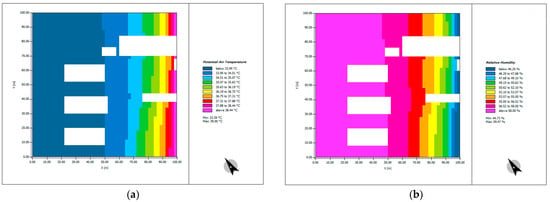
Figure 9.
(a) ENVI-met simulated Ta distribution on 27 July 2020 at 15:00 p.m.; (b) ENVI-met simulated RH distribution on 27 July 2020 at 15:00 p.m.
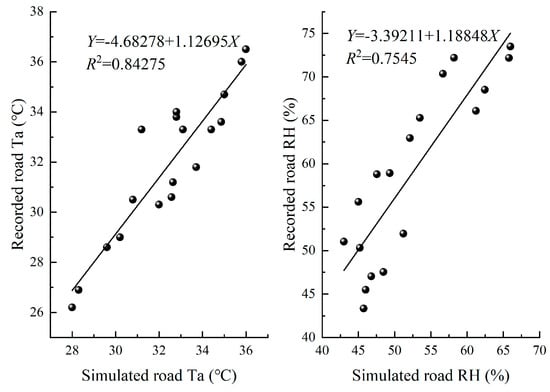
Figure 10.
The correlation degree between simulated and measured data of road space.
4. Discussions
4.1. The Impact of Microclimatic Transients on the Willingness to Use the Outdoor Environment of the Elderly
Although the thermal comfort zone of the outdoor spaces obtained from previous cases located in different climate zones varied widely, such as the climate zones across Europe reporting a difference of 10 °C in thermal neutral temperature, many researchers recognized that outdoor thermal comfort is the main factor that determines the quality and use of outdoor spaces [,]. However, the present study showed that Ta and RH differences between indoor and outdoor spaces were the primary meteorological factors that influenced the elderly’s usage of outdoor spaces. Only when the ΔTa and ΔRH are small enough to resemble a steady-state (ΔUTCI ≤ 0.5 °C) could the difference in WS and SI between indoor and outdoor spaces affect the elderly’s choice of using outdoor space. Therefore, as a vulnerable group, the elderly living in nursing homes need a stable and small microclimatic difference between indoor and outdoor spaces.
4.1.1. Influence of Ta and ΔTa on the Use of Outdoor Space by the Elderly
Lin et al. [] recommended 26 °C as the optimum Ta to achieve the lowest mortality for Chinese elderly, and people feel most comfortable when the thermal sensation is near optimum Ta. The present study showed that only in spring were the mean Ta values of all the indoor and outdoor spaces in this nursing home closest to the optimum Ta. However, in summer, the mean Ta of outdoor spaces was higher than the low-heat mortality Ta limit of 29 °C. The elderly are more sensitive to high temperatures []. Together with the UTCI values, it is necessary to decrease Ta of all outdoor spaces in summer, especially the garden and roads. In winter, the mean Ta of each space here was less than 13 °C, especially in corridor (11.81 °C). Collins and Exton-Smith [] have pointed out that Ta below 15 °C negatively affects health by increasing the burden on the elderly circulatory system. They indicated that all spaces here in winter are uncomfortable spaces, and it is necessary to increase the Ta of all spaces in winter.
A previous study suggested that it is better to control the transition temperature difference (ΔTa) within 5 °C []. However, sudden hot/cold exposure could cause enormous health risks for the elderly. Moreover, for a 1 °C increase of Ta in summer, the mortality levels due to cardiovascular, respiratory, and cerebrovascular failures in the elderly increased by 3.44%, 3.60%, and 1.40%, respectively []. In addition, every 1 °C reduction in Ta in winter also caused a 1–2% increase in mortality []. The reason for this may be the weak thermoregulatory responses of the elderly to sudden cold and hot environments []. In this research, the annual mean |ΔT2| and |ΔT3| values exceeded 2.00 °C. In spring and summer, |ΔT2| and |ΔT3| levels exceeded 3.20 °C. Undoubtedly, the high ΔTa increases the heat-related risk of using road and garden for the elderly. Moreover, although the ΔT1 was the smallest in winter, during 9:00 a.m. to 10:00 a.m., Ta (corridor) was also more than 1° lower than Ta (indoors). The elderly should postpone the time of using corridors in winter. Overall, it is necessary to decrease the Ta of road and garden to reduce |ΔT2| and |ΔT3| in summer and to increase the Ta of all spaces to reduce |ΔTa| in winter.
4.1.2. Influence of SR and ΔSR on the Use of Outdoor Space by the Elderly
Moderate sunlight exposure benefits human health, e.g., by promoting the synthesis of vitamin D []. A lack of vitamin D can easily cause increased mortality and a functional impairment in the lower extremities, which increases the risk of falls and fractures in the elderly []. Previous research has indicated that vitamin D deficiency in the elderly is a common health problem across the world, and ranges from 78% to 98% in the elderly living in nursing homes []. The present study found that the seasonal mean SR was less than 80 W/m2 in autumn and winter. Moreover, the seasonal indoor SR values were stable and low (0.95–16.62 W/m2). Staying indoors for a long time is unfavorable for the health of the elderly, and it is therefore necessary to encourage them to use outdoor spaces.
In the present study, the highest mean ΔSR (|ΔSR2| = 253.30 W/m2) occurred between indoor space and roads, followed by |ΔSR3| (145.75 W/m2) between indoor spaces and gardens. The highest seasonal |ΔSR2| exceeded 340.00 W/m2 in spring and summer. When the elderly move from indoor spaces to outdoor spaces, the huge difference in solar exposure can cause them to experience the glare effect. The elderly are the most sensitive population for the glare effect []. Along with this increased susceptibility to glare, their recovery time from dazzling and disability glare also increases [], which could produce squinting, annoyance, and an aversive mood, and also increases the risk of falls []. That could be the reason why the elderly prefer to stay in corridors with the relatively minimal ΔSR1. In addition, elders should also avoid long lasting or high-intensity outdoor sunlight, as the exposure to sunlight increases the risk of skin cancer []. As Samefors et al. [] pointed out, staying outdoors for 20–30 min per day is sufficient for the synthesis of vitamin D. Thus, the solar design of the outdoor environment for the elderly must reduce unobstructed sunlight exposure. Moreover, ΔSR between indoor and outdoor spaces must be decreased synchronously to balance the risks and benefits of sun exposure.
4.1.3. Influence of RH and ΔRH on the Use of Outdoor Spaces by the Elderly
In the present study, the mean RH values of indoor (68.35%) spaces and corridors (62.10%) exceeded the comfortable and healthy range (40–60%). Especially in summer and autumn, the RH(indoors) values far exceeded 70%, which has been associated with an increased exposure risk to fungi, mildew, and dust mites []. As indicated by Lin et al. [,], increasing RH (≥60%) is more dangerous for the elderly when the temperatures are high in the summer. This may be due to the weak sunlight and poor ventilation, which cause volatilized water to remain indoors.
The seasonal mean ΔRH2 and ΔRH3 ranged from 9.74% to 13.20%, and the maximum value ΔRH3 (20.66%) was measured in summer. This indicates that outdoor spaces provide a dehumidification effect. Correlation analysis confirmed that, the smaller the ΔRH of indoor and outdoor spaces is, the more attractive the outdoor space is to the elderly. As Tyrovolas et al. [] showed, people’s positive moods are correlated with a lower humidity range, and with a decreased humidity difference. In addition, a study in Tunisia suggested that for each 1% increase in RH above 57.8%, there was a 5% increase in disease []. Thus, to enhance the enthusiasm of the elderly for using outdoor spaces, nursing homes should provide a drier indoor space to decrease the ΔRH between indoor and outdoor spaces.
Despite its physiological importance, RH is rarely the explicit focus of health impact studies having an independent role []. We also found that ΔRH should be treated as a confounding variable related to ΔTa or ΔUTCI to identify its contribution to transient thermal comfort. When ΔUTCI was less than 0.5 °C or ΔTa was less than 1.4 °C, the instant RH drop does not have any obvious effect on the thermal comfort of the normally clothed elderly. Thus, the impact of the small RH drop (less than 25%) on the aged thermal comfort could be neglected in the steady-state environment with no heat stress or even the moderate heat stress level.
4.1.4. Influence of WS and ΔWS on the Use of Outdoor Spaces by the Elderly
Wind is one of the environmental determinants of the thermos-physiological state of the body and an important factor determining the safety of outdoor spaces for the elderly []. Weak WS may intensify thermal discomfort in urban spaces. However, research on optimizing the outdoor wind environment for human comfort remains relatively underdeveloped []. The present study found that all spaces of the Wanxia nursing home had calm wind conditions (<0.2 m/s) in all seasons. The ΔWS values between indoor and outdoor spaces were very small and showed no significant difference. This implied that ΔWS could be the least important factor influencing the use of outdoor spaces by the elderly in nursing home of Chengdu City. Moreover, because of the calm wind environment of the city, the safety of the outdoor wind environment for nursing homes in Chengdu City is not the important safety factor. This phenomenon differed from previous reports for Wellington, New Zealand [], and Lisbon, Portugal [], which pointed out that wind speed, is the most important factor determining the satisfaction of urban outdoor space users.
Nevertheless, calm wind easily causes the high Ta and RH environment of the nursing home to be less comfortable in summer, and even produces a stifling feeling. Moreover, it is not conducive to the diffusion of air pollutants. In Hong Kong, the thermal comfort of people in summer requires the WS to be at least 1.6 m/s []. Most people prefer a light breeze (1.4–3.1 m/s) in all seasons []. Although no report has been published about the effects of sudden wind variations on human health, when comfort level is considered, it is necessary to increase ΔWS of both indoor and outdoor spaces in nursing home.
4.2. How Can Indoor and Outdoor Microclimatic Differences of the Nursing Home Be Controlled?
In general, all the investigated spaces in nursing homes presented the risks of heat stress in summer. Moreover, both road and garden spaces were even at risk of heat stress in spring. The user numbers of both roads and gardens were significantly correlated with ΔTa and ΔRH. Therefore, we took road and bedroom spaces as the simulated cases to study adjustment strategies. Two strategies are proposed for the reduction of ΔTa and ΔRH at 15:00 in 27 July 2020, to encourage the use of outdoor spaces by the elderly, as follows.
Firstly, to reduce ΔTa between indoor and outdoor spaces, the Ta and SR of outdoor spaces must be reduced. As shaded spaces will enable the avoidance of direct sunlight, reduce outdoor thermal discomfort, and even produce flowing wind, extensive shading should be added across all outdoor spaces of the nursing home to reduce outdoor Ta and SR. Shading methods include trees, pergolas, shading devices, galleries, and overhanging facades. A series of previous studies found that trees have a marginally better cooling effect than shading devices []. Thus, passive shade with a tree canopy was proposed to add to the road spaces of this nursing home. During the simulation, we set three tree canopy coverage gradients of 50%, 75% (Figure 11a), and 100%. Results showed that 75% canopy coverage had an optimal cooling (1.95 °C) and dehumidification (1.22%) effect on road spaces (Figure 11b,c). Moreover, this will reduce the ΔTa of indoor and outdoor spaces by approximately 2 °C.
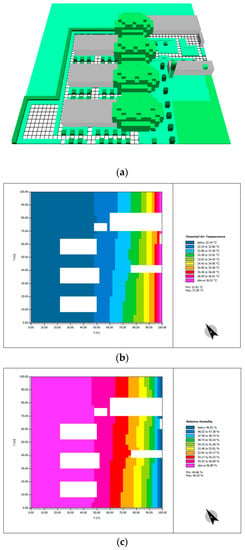
Figure 11.
(a) ENVI-met model of the road area with 75% coverage; (b) ENVI-met simulated Ta distribution on 27 July 2020 at 15:00 p.m. under 75% road coverage; (c) ENVI-met simulated RH distribution on 27 July 2020 at 15:00 p.m. under 75% road coverage.
In addition, this strategy is also helpful for the elderly to avoid suffering from the glare effect. However, with these shading options, care must be taken to avoid over-shading in autumn and winter, because the Chengdu Plain receives the least direct solar radiation in China []. Therefore, deciduous trees that sprout early in spring, such as Koelreuteria paniculata, Firmiana simplex, Erythrina corallodendron, and Toona sinensis, are suggested to be popularly used in outdoor spaces.
Secondly, to reduce ΔRH, the indoor RH must be decreased. A reduction in indoor RH of less than 25% should be recommended for the nursing home. Mechanical ventilation systems should be popularly used to decrease the seasonal RH of indoor spaces to 50–60%, especially in summer, and ΔRH between indoor and outdoor spaces should be controlled within 5%. Indoor ventilation could accelerate the evaporation of indoor moisture, and have a passive indoor cooling effect.
Combined with the requirements of the “Design code for buildings of home for the age in Sichuan province” (DBJ51/ 052-2015), the ventilation rate (ACH), which means the air changes per hour of the residential houses for the elderly should be not less than 1.5 ACH []. Based on the minimum ACH (1.5) and RH requirements, the minimum fresh air volume was simulated. In order to minimize the impact on the elderly, the airflow organization of mechanical ventilation is designed as top air supply and top return air (Figure 12). Simulation results showed that the fresh air volumes of 120 m3/h (30 m³/h per capita), should be recommended for reducing indoor RH to 50%, and the ΔRH between indoor and outdoor spaces will be controlled within 5% (Figure 13a,b). At the same time, there is no obvious fluctuation of indoor Ta (Figure 13c,d), and the mean horizontal WS remains at 0.03 m/s (Figure 13e,f).
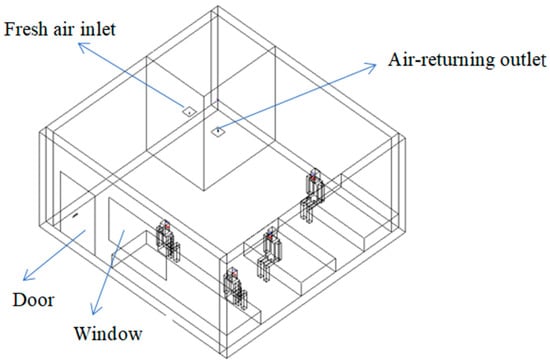
Figure 12.
The arrangement of the mechanical ventilation.
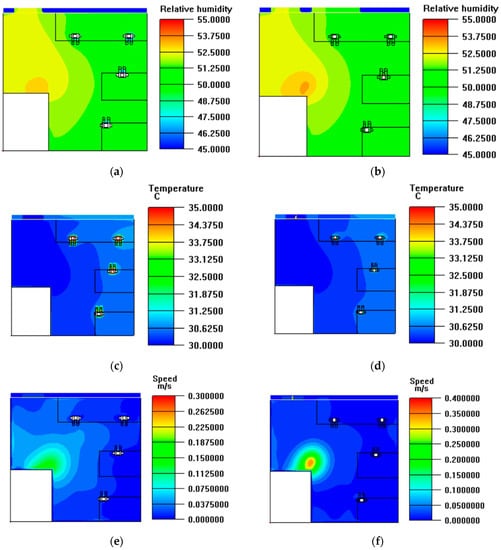
Figure 13.
Indoor environment Simulation under mechanical ventilation. (a) indoor RH distribution cloud map of the 0.6 m height section; (b) indoor RH distribution cloud map of the 1.2 m height section; (c) indoor Ta distribution cloud map of the 0.6 m height section; (d) indoor Ta distribution cloud map of the 1.2 m height section; (e) indoor WS distribution cloud map of the 0.6 m height section; (f) indoor WS distribution cloud map of the 0.6 m height section.
4.3. The Limitations
In the present study, the analyses of transient thermal comfort and design strategies were based on our understanding of physical, physiological perspectives, and direct observations. In fact, several other factors could influence the elderly’s thermal comfort and subsequently their usage patterns of outdoor space, such as land characteristics (e.g., surface coverage and safety), physiological parameters (e.g., age, gender, heart rate, and skin temperature), and psychological parameters (e.g., alliesthesia, thermal history, expectation, and mood) [,]. This study lacked an assessment of the impact of elderly psychology on their usage patterns of outdoor spaces. This was due to most of the participants here being too old to accurately describe their psychological feelings and needs. In addition, although the different age groups of old people could have a large gap in transient thermal comfort, because almost all the subjects of this study were over 80 years old, our research results mainly focused on the age of elderly.
5. Conclusions
In this study, the elderly lived in the biggest private nursing home of Chengdu, China, with the relationships of the thermal comfort under a transient state to their choice of using outdoor space examined using microclimatic measurements and observation recording the following. Large microclimatic differences between the indoor and outdoor spaces of this nursing home were found in seasons, which affected the elderly’s willingness to use outdoor spaces. In general, people can adapt to microclimatic differences by removing or adding clothing. However, because the elderlies’ responses to environmental change lag behind, they find it difficult to adjust in time and adapt to environmental changes. Thus, the above series of age-friendly design strategies was necessary to reduce the microclimatic differences for improving the health and well-being of the elderly. We concluded the following:
- (1)
- The UTCI values of the different spaces in the nursing homes showed the significant differences in spring and summer. The stress categories of indoor and corridor spaces were at a level with no thermal stress in spring, autumn, and winter. In summer, the mean UTCI values of indoor and corridor spaces corresponded to the level of moderate heat stress, while those of road and garden corresponded to the level of strong heat stress (≥33 °C). Road and garden spaces even showed moderate heat stress (≥25 °C, <33 °C) in spring.
- (2)
- The microclimatic differences between indoor and outdoor spaces ranged from 0.47 °C to 2.93 °C (|ΔTa|), from 86.09 W/m2 to 206.76 W/m2 (|ΔSR|), from 5.29% to 14.76% (ΔRH), from 0.01 m/s to 0.07 m/s (|ΔWS|), and from 0.25 °C to 2.25 °C (ΔUTCI). The minimal microclimatic differences occurred between corridors and indoors.
- (3)
- Ta and RH differences between indoor and outdoor spaces were the primary meteorological factors influencing the elderly’s usage of outdoor spaces. The elderly preferred a constant Ta and RH environment. Only when the ΔTa and ΔRH are small enough to resemble a steady-state (ΔUTCI ≤ 0.5 °C) will the difference in WS and SI between indoor and outdoor spaces affect the elderly’s choice of using outdoor space.
- (4)
- Two optimal design strategies were put forward for creating comfortable transient environments from physical perspectives, including improving outdoor canopy coverage and indoor mechanical ventilation.
Author Contributions
Conceptualization, H.Z. and T.Z.; Formal analysis, J.S.; Funding acquisition, H.Z.; Investigation, J.W., T.Z. and X.C.; methodology, J.W., J.S. and X.C.; Writing—original draft, H.Z. All authors have read and agreed to the published version of the manuscript.
Funding
This work was supported by the National Natural Science Foundation of China (No. 31971716).
Conflicts of Interest
The authors declare no conflict of interest.
References
- Yang, L.; Liu, J.; Lu, Y.; Ao, Y.; Guo, Y.Y.; Huang, W.C.; Zhao, R.; Wang, R.Y. Global and local associations between urban greenery and travel propensity of older adults in Hong Kong. Sustain. Cities Soc. 2020, 63, 102442. [Google Scholar] [CrossRef]
- Yang, L.; Ao, Y.; Ke, J.; Lu, Y.; Liang, Y. To walk or not to walk? Examining non-linear effects of streetscape greenery on walking propensity of older adults. J. Transp. Geogr. 2021, 94, 103099. [Google Scholar] [CrossRef]
- Yang, L.; Tang, X.; Yang, H. Using a system of equations to assess the determinants of the walking behavior of older adults. Trans. GIS 2022, 26, 1339–1354. [Google Scholar] [CrossRef]
- Zhang, H. Sending parents to nursing homes is unfilial? An exploratory study on institutional elder care in China. Int. Soc. Work 2019, 62, 351–362. [Google Scholar] [CrossRef]
- Xu, J.; Zhu, B.S. A research on Beds Occupation rate of Pension Agency and Its Influencing Factors: Taking Beijing as an Example. Popul. Econ. 2019, 3, 115–126. [Google Scholar] [CrossRef]
- Xing, Y.; Pei, R.; Qu, J.; Wang, J.; Zhou, H.; Wang, Z.Q.; Yan, W.X.; Sun, X.R.; Sun, T.; Li, L. Urban-rural differences in factors associated with willingness to receive eldercare among the elderly: A cross-sectional survey in China. BMJ 2018, 8, e020225. [Google Scholar] [CrossRef]
- Mendes, A.; Luísa Papoila, A.; Carreiro-Martins, P.; Aguiar, L.; Bonassi, S.; Caires, I.; Palmeiro, T.; Silva Ribeiro, A.; Neves, P.; Pereira, C.; et al. The Influence of Thermal Comfort on the Quality of Life of Nursing Home Residents. J. Toxicol. Environ. Health Part A 2017, 80, 729–739. [Google Scholar] [CrossRef]
- Panraluk, C.; Sreshthaputra, A. Thermal Comfort of the Elderly in Public Health Service Buildings of Thailand. Appl. Mech. Mater. 2018, 878, 173–178. [Google Scholar] [CrossRef]
- Sinoo, M.M.; Hoof, J.V.; Kort, H.S.M. Light conditions for older adults in the nursing home: Assessment of environmental illuminances and colour temperature. Build. Environ. 2011, 46, 1917–1927. [Google Scholar] [CrossRef]
- Hayashi, Y.; Ikaga, T.; Ando, S.; Hoshi, T. The Impact of indoor thermal environment in winter on deterioration of care level in nursing home residents: A field survey on indoor thermal environment of nursing home and resident’s care condition. J. Environ. Eng. 2018, 83, 225–233. [Google Scholar] [CrossRef][Green Version]
- Hase, H.; Ando, Y.; Sakurai, N.; Ohno, H. The influence of room temperature and relative humidity on odor in a unit-type nursing home. In Proceedings of the 6th International Conference on Indoor Air Quality, Ventilation & Energy Conservation in Buildings IAQVEC, Sendai, Japan, 28–31 October 2007; pp. 201–206. [Google Scholar]
- Walikewitz, N.; Jnicke, B.; Langner, M.; Endlicher, W. Assessment of indoor heat stress variability in summer and during heat warnings: A case study using the UTCI in berlin, Germany. Int. J. Biometeorol. 2015, 62, 29–42. [Google Scholar] [CrossRef] [PubMed]
- Höppe, P. Different aspects of assessing indoor and outdoor thermal comfort. Build. Environ. 2002, 34, 661–665. [Google Scholar] [CrossRef]
- Fenner, D.; Meier, F.; Scherer, D.; Polze, A. Spatial and temporal air temperature variability in Berlin, Germany, during the years 2001–2010. Urban Clim. 2014, 10, 308–331. [Google Scholar] [CrossRef]
- Jiao, Y.; Yu, H.; Wang, T.; An, Y.S.; Yu, Y.F. Thermal comfort and adaptation of the elderly in free-running environments in Shanghai, China. Build. Environ. 2017, 118, 259–272. [Google Scholar] [CrossRef]
- Adevi, A.A.; MaRtensson, F. Stress rehabilitation through garden therapy: The garden as a place in the recovery from stress. Urban For. Urban Green. 2013, 12, 230–237. [Google Scholar] [CrossRef]
- Arnberger, A.; Allex, B.; Eder, R.; Ebenberger, M.; Wank, A.; Kolland, F.; Wallner, P.; Hutterc, H.P. Elderly resident’s uses of and preferences for urban green spaces during heat periods. Urban For. Urban Green. 2017, 21, 102–115. [Google Scholar] [CrossRef]
- Wang, D.; Glicksman, A. Being Grounded: Benefits of Gardening for Older Adults in Low-Income home. J. Home Elder. 2013, 27, 89–104. [Google Scholar] [CrossRef]
- Goto, S.; Park, B.J.; Tsunetsugu, Y.; Herrup, K.; Miyazaki, Y. The effect of garden designs on mood and heart output in older adults residing in an assisted living facility. Herd 2013, 6, 27–42. [Google Scholar] [CrossRef]
- Zong, H.; Liu, Y.; Wang, Q.; Liu, M.L.; Chen, H. Usage patterns and comfort of gardens: A seasonal survey of internal garden microclimate in the aged care homes of Chengdu City. Int. J. Biometeorol. 2019, 63, 1181–1192. [Google Scholar] [CrossRef]
- Chen, L.; Ng, E. Outdoor thermal comfort and outdoor activities: A review of research in the past decade. Cities. 2012, 29, 118–125. [Google Scholar] [CrossRef]
- Wei, D.; Yang, L.; Bao, Z.; Lu, Y.; Yang, H.T. Variations in outdoor thermal comfort in an urban park in the hot-summer and cold-winter region of China. Sustain. Cities Soc. 2022, 77, 103535. [Google Scholar] [CrossRef]
- Baquero Larriva, M.T.; Higueras, E. Health risk for older adults in Madrid, by outdoor thermal and acoustic comfort. Urban Clim. 2020, 34, 100724. [Google Scholar] [CrossRef]
- Rivera-Gómez, C.; Diz-Mellado, E.; Galán-Marín, C.; López-Cabeza, V. Tempering potential-based evaluation of the courtyard microclimate as a combined function of aspect ratio and outdoor temperature. Sustain. Cities Soc. 2019, 51, 101740. [Google Scholar] [CrossRef]
- Apolonio Callejas, I.J.; Cleonice Durante, L.; Diz-Mellado, E.; Galán-Marín, C. Thermal Sensation in Courtyards: Potentialities as a Passive Strategy in Tropical Climates. Sustainability. 2020, 12, 6135. [Google Scholar] [CrossRef]
- Teno, J.M.; Gozalo, P.; Khandelwal, N.; Curtis, J.R.; Meltzer, D.; Engelberg, R.; Mor, V. Association of Increasing Use of Mechanical Ventilation Among Nursing Home Residents with Advanced Dementia and Intensive Care Unit Beds. JAMA Intern. Med. 2016, 176, 1809–1816. [Google Scholar] [CrossRef]
- Steiner, V.; Ames, A.; Milz, S.A.; Dubin, S. Nursing home staff’s perceptions of noise compared to measured noise levels: A descriptive study. J. Gerontol. Nurs. 2020, 46, 37–45. [Google Scholar] [CrossRef]
- Du, X.Y.; Li, B.Z.; Liu, H.Y.; Yang, D.; Yu, W.; Liao, J.K.; Huang, Z.C.; Xia, K.C.; McKemy, D.D. The Response of Human Thermal Sensation and Its Prediction to Temperature Step-Change (Cool-Neutral-Cool). PLoS ONE. 2014, 9, e104320. [Google Scholar] [CrossRef]
- Van Loenhout, J.A.F.; Le Grand, A.; Duijm, F.; Greven, F.; Vink, N.M.; Hoek, G.; Zuurbier, M. The effect of high indoor temperatures on self-perceived health of elderly persons. Environ. Res. 2016, 146, 27–34. [Google Scholar] [CrossRef]
- Bunker, A.; Wildenhain, J.; Vandenbergh, A.; Henschke, N.; Rocklöv, J.; Hajat, S.; Sauerborn, R. Effects of air temperature on climate-sensitive mortality and morbidity outcomes in the elderly; a systematic review and meta-analysis of epidemiological evidence. Ebiomedicine. 2016, 6, 258–268. [Google Scholar] [CrossRef]
- Kario, K.; Ikemoto, T.; Kuwabara, M.; Ishiyama, H.; Saito, K.; Hoshide, S. Catheter-based renal denervation reduces hypoxia-triggered nocturnal blood pressure peak in obstructive sleep apnea syndrome. J. Clin. Hypertens. 2016, 18, 707–709. [Google Scholar] [CrossRef]
- Yang, L.; Liang, Y.; He, B.; Lu, Y.; Gou, Z. COVID-19 effects on property markets: The pandemic decreases the implicit price of metro accessibility. Tunn. Undergr. Space Technol 2022, 125, 104528. [Google Scholar] [CrossRef]
- Yu, J.; Yang, C.; Tian, L.; Liao, D. A study on optimum insulation thicknesses of external walls in hot summer and cold winter zone of China. Appl. Energy. 2009, 86, 2520–2529. [Google Scholar] [CrossRef]
- National Bureau of Statistics. Statistical Bulletin on National Economic and Social Development. 2018. Available online: http://www.stats.gov.cn/tjsj/zxfb/201902/t20190228_1651265.html (accessed on 1 October 2021).
- Jia, J.; Ni, C.J.; Hu, Z.Y.; Xie, J.; Xie, Y. Variation of haze and its relationship with climate change in Chengdu from 1980 to 2010. Plateau Meteorol. 2017, 36, 517–527. [Google Scholar] [CrossRef]
- Zhou, X.; Zheng, C.; Qiang, Y.; Ingvar, H.; Gao, C.S.; Kalev, K. The thermal insulation difference of clothing ensembles on the dry and perspiration manikins. Meas. Sci. Technol. 2010, 21, 085203. [Google Scholar] [CrossRef]
- Park, S.; Tuller, S.E.; Jo, M. Application of universal thermal climate index (UTCI) for microclimatic analysis in urban thermal environments. Landsc. Urban Plan. 2014, 125, 146–155. [Google Scholar] [CrossRef]
- Cheung, P.K.; Jim, C.Y. Determination and application of outdoor thermal benchmarks. Build. Environ. 2017, 123, 333–350. [Google Scholar] [CrossRef]
- Zhang, M.J.; You, W.; Qin, Q.; Peng, D.; Hu, Y.; Gao, Z.; Buccolieri, R. Investigation of typical residential block typologies and their impact on pedestrian-level microclimate in summers in Nanjing, China. Front. Archit. Res. 2021, 11, 278–296. [Google Scholar] [CrossRef]
- Xue, J.; Hu, X.; Shu, S.N.; Wu, Y.; Li, X.; Chai, L.; Lai, D. Outdoor Thermal Comfort at a University Campus: Studies from Personal and Long-Term Thermal History Perspectives. Sustainability 2020, 12, 9284. [Google Scholar] [CrossRef]
- Błażejczyk, K.; Bröde, P.; Fiala, D.; Havenith, G.; Kunert, A. Principles of the new universal thermal climate index (UTCI) and its application. Misc. Geogr. 2010, 14, 91–102. [Google Scholar] [CrossRef]
- Wang, B.; Yi, Y.K. Developing an adapted utci (universal thermal climate index) for the elderly population in china’s severe cold climate region. Sustain. Cities Soc. 2021, 69, 102813. [Google Scholar] [CrossRef]
- Grifoni, R.C.; Tascini, S.; Cesario, E.; Marchesani, G.E. Cool façade optimization: A new parametric methodology for the urban heat island phenomenon (UHI). In Proceedings of the 2017 IEEE International Conference on Environment and Electrical Engineering and 2017 IEEE Industrial and Commercial Power Systems Europe (EEEIC/I&CPS Europe), Milan, Italy, 6–9 June 2017; pp. 1–5. [Google Scholar] [CrossRef]
- Bröde, P.; Fiala, D.; Blazejczyk, K.; Holmér, I.; Jendritzky, G.; Kampmann, B.; Tinz, B.; Havenith, G. Deriving the operational procedure for the universal thermal climate index (UTCI). Int. J. Biometeorol. 2012, 56, 481–494. [Google Scholar] [CrossRef] [PubMed]
- Talhi, A.; Barlet, A.; Bruneau, D.; Boudjamâa, A. Towards a prediction of outdoor human thermal comfort adapted for designers of urban spaces: Examining UTCI and APCI in the context of Algiers (Algeria). Int. J. Biometeorol. 2020, 64, 651–662. [Google Scholar] [CrossRef] [PubMed]
- Lai, D.Y.; Guo, D.H.; Hou, Y.F.; Lin, C.; Chen, Q. Studies of outdoor thermal comfort in northern China. Build. Environ. 2014, 77, 110–118. [Google Scholar] [CrossRef]
- Lin, Y.K.; Ho, T.J.; Wang, Y.C. Mortality risk associated with temperature and prolonged temperature extremes in elderly populations in Taiwan. Environ. Res. 2011, 111, 1156–1163. [Google Scholar] [CrossRef] [PubMed]
- Collins, K.J.; Exton-Smith, A.N. Thermal homeostasis in old age. J. Am. Geriatr. Soc. 1983, 31, 519–524. [Google Scholar]
- Tochihara, Y.; Yamashita, K.; Fujii, K.; Kaji, Y.; Wakabayashi, H.; Kitahara, H. Thermoregulatory and cardiovascular responses in the elderly towards a broad range of gradual air temperature changes. J. Therm. Biol. 2021, 99, 103007. [Google Scholar] [CrossRef]
- Okan, F.; Okan, S.; Zincir, H. Effect of sunlight exposure on vitamin d status of individuals living in a nursing home and their own homes. J. Clin. Densitom. 2020, 23, 21–28. [Google Scholar] [CrossRef]
- Hanley, D.A.; Cranney, A.; Jones, G.; Whiting, S.J.; Leslie, W.D. Vitamin d in adult health and disease: A review and guideline statement from osteoporosis Canada. Can. Med. Assoc. J. 2010, 182, 1315–1319. [Google Scholar] [CrossRef]
- Arnljots, R.; Arnljots, E.S.; Thorn, J.; Marie, J.E.; Michael, M.; Pär-Daniel, S. Bacteriuria and vitamin D deficiency: A cross sectional study of 385 nursing home residents. BMC Geriatr. 2019, 19, 381. [Google Scholar] [CrossRef]
- Wolf, E. Glare and age. Arch. Ophthalmol. 1960, 64, 502–514. [Google Scholar] [CrossRef]
- Van Den Berg, T.J.; Franssen, L.; Coppens, J.E. Straylight in the human eye: Testing objectivity and optical character of the psychophysical measurement. Spec. Issue 4th Eur. Meet. Vis. Physiol. Opt. (EMPO) 2009, 29, 345–350. [Google Scholar] [CrossRef] [PubMed]
- Alessio, F.; Roberta, D.; Daniele, Z. The glare effect test and the impact of age on luminosity thresholds. Front. Psychol. 2017, 8, 1132–1134. [Google Scholar] [CrossRef]
- Mead, M.N. Benefits of sunlight: A bright spot for human health. Environ. Health Perspect. 2008, 116, A160. [Google Scholar] [CrossRef] [PubMed]
- Samefors, M.; Tengblad, A.; Östgren, C.J. Sunlight Exposure and Vitamin D Levels in Older People-An Intervention Study in Swedish Nursing Homes. J. Nutr. Health Aging 2020, 24, 1047–1052. [Google Scholar] [CrossRef]
- Wolkoff, P.; Kjaergaard, S.K. The dichotomy of relative humidity on indoor air quality. Environ. Int. 2007, 33, 850–857. [Google Scholar] [CrossRef]
- Barreca, A.I. Climate change, humidity, and mortality in the United States. J. Environ. Econ. Manag. 2012, 63, 19–34. [Google Scholar] [CrossRef]
- Tyrovolas, S.; Chalkias, C.; Morena, M.; Kleomenis, K.; Nikos, T.; Akis, Z.; Efthimios, G.; George, M.; Vassiliki, B.; Christos, L.; et al. High relative environmental humidity is associated with diabetes among elders living in Mediterranean islands. J. Diabetes Metab. Disord. 2014, 13, 1. [Google Scholar] [CrossRef][Green Version]
- Toumi, A.; Chlif, S.; Bettaieb, J.; Alaya, N.; Boukthir, A.; Ahmadi, Z.E.; Salah, A.B.; Ozcel, M.A. Temporal dynamics and impact of cli- mate factors on the incidence of zoonotic cutaneous leishmaniasis in central Tunisia. PLoS Negl. 2012, 6, e1633. [Google Scholar] [CrossRef]
- Davis, R.E.; McGregor, G.R.; Enfield, K.B. Humidity: A review and primer on atmospheric moisture and human health. Environ. Res. 2016, 144, 106–116. [Google Scholar] [CrossRef]
- Sadeghi, M.; de Dear, R.; Wood, G.; Samali, B. Development of a bioclimatic wind rose tool for assessment of comfort wind resources in Sydney, Australia for 2013 and 2030. Int. J. Biometeorol. 2018, 62, 1963–1972. [Google Scholar] [CrossRef]
- Ng, E.; Cheng, V. Urban human thermal comfort in hot and humid Hong Kong. Energy Build. 2012, 55, 51–65. [Google Scholar] [CrossRef]
- Walton, D.; Dravitzki, V.; Donn, M. The relative influence of wind, sunlight and temperature on user comfort in urban outdoor spaces. Build. Environ. 2007, 42, 3166–3175. [Google Scholar] [CrossRef]
- Andrade, H.; Alcoforado, M.J.; Oliveira, S. Perception of temperature and wind by users of public outdoor spaces: Relationships with weather parameters and personal characteristics. Int. J. Biometeorol. 2011, 55, 665–680. [Google Scholar] [CrossRef] [PubMed]
- Niu, J.; Liu, J.; Lee, T.C.; Niu, J.L.; Liu, J.L.; Lee, T.Z.; Lin, Z.; Mak, C.; Tse, K.T.; Tang, B.; et al. A new method to assess spatial variations of outdoor thermal comfort: Onsite monitoring results and implications for precinct planning. Build. Environ. 2015, 91, 263–270. [Google Scholar] [CrossRef]
- Dhariwal, J.; Manandhar, P.; Bande, L.; Marpu, P.; Armstrong, P.; Reinhart, C.F. Evaluating the effectiveness of outdoor evaporative cooling in a hot, arid climate. Build. Environ. 2019, 150, 281–288. [Google Scholar]
- Luo, H.; Liu, X.; Anderson, B.C.; Zhang, K.; Li, X.T.; Huang, B.; Li, M.; Mo, Y.; Fan, L.Q.; Shen, Q.; et al. Carbon sequestration potential of green roofs using mixed-sewagesludge substrate in Chengdu World Modern Garden City. Ecol. Indic. 2015, 49, 247–259. [Google Scholar] [CrossRef]
- Shajahan, A.; Culp, C.H.; Williamson, B. Effects of indoor environmental parameters related to building heating, ventilation, and air conditioning systems on patients’ medical outcomes: A review of scientific research on hospital buildings. Indoor Air. 2019, 29, 161–176. [Google Scholar] [CrossRef]
- Aghamolaei, R.; Lak, A. Outdoor Thermal Comfort for Active Ageing in Urban Open Spaces: Reviewing the Concepts and Parameters. Ageing Int. 2022. [Google Scholar] [CrossRef]
- Yang, L.; Liu, J.; Liang, Y.; Lu, Y.; Yang, H. Spatially varying effects of street greenery on walking time of older adults. ISPRS Int. J. Geo-Inf. 2021, 10, 596. [Google Scholar] [CrossRef]
Publisher’s Note: MDPI stays neutral with regard to jurisdictional claims in published maps and institutional affiliations. |
© 2022 by the authors. Licensee MDPI, Basel, Switzerland. This article is an open access article distributed under the terms and conditions of the Creative Commons Attribution (CC BY) license (https://creativecommons.org/licenses/by/4.0/).